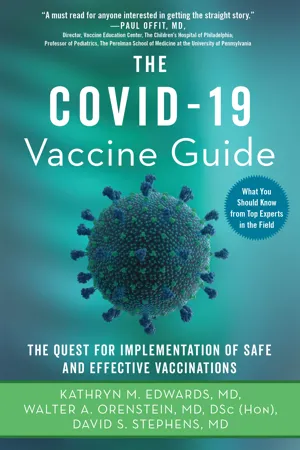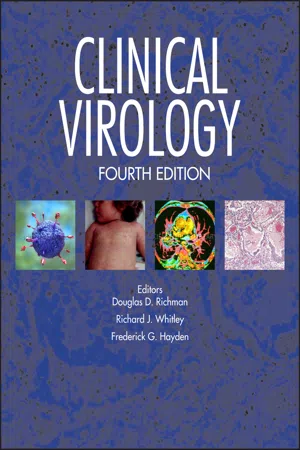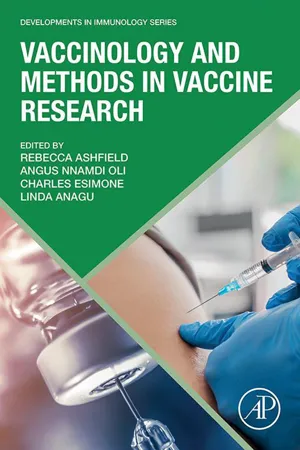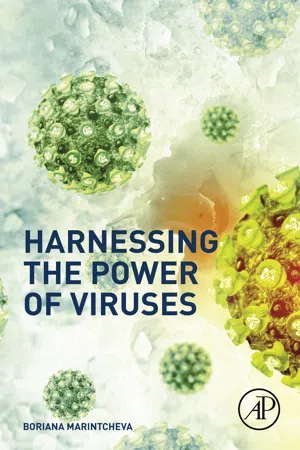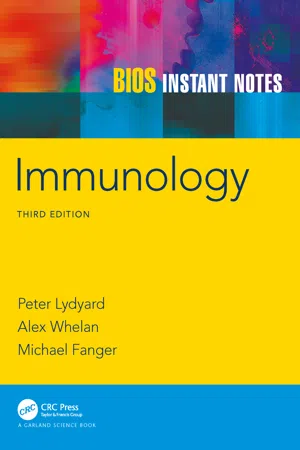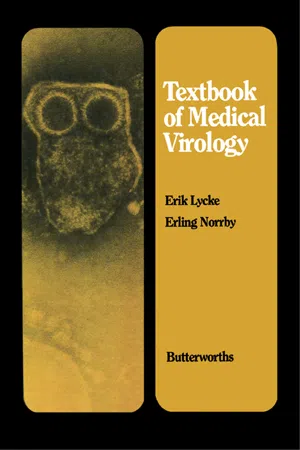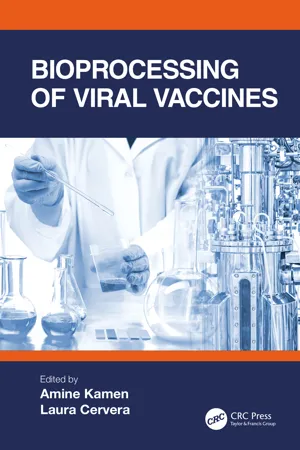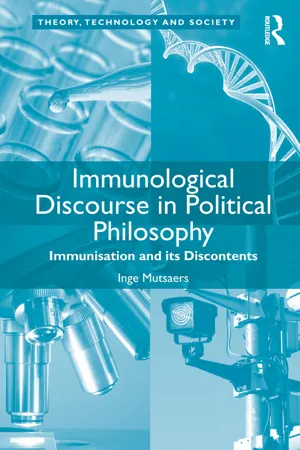Biological Sciences
Vaccine Immunity
Vaccine immunity refers to the protection against a specific infectious disease that is acquired through vaccination. When a person is vaccinated, their immune system is stimulated to produce an immune response, leading to the development of immunity against the targeted pathogen. This immunity can help prevent infection and reduce the severity of the disease if exposure occurs.
Written by Perlego with AI-assistance
Related key terms
Related key terms
1 of 4
Related key terms
1 of 3
10 Key excerpts on "Vaccine Immunity"
- eBook - ePub
The Covid-19 Vaccine Guide
The Quest for Implementation of Safe and Effective Vaccinations
- Kathryn M. Edwards, Walter A. Orenstein, David S. Stephens(Authors)
- 2021(Publication Date)
- Skyhorse(Publisher)
Chapter 2 Introduction to Vaccines and VaccinologyV accines are the most cost-effective intervention for preventing human disease. What is a vaccine? How does it work? How do vaccines protect?A vaccine is a substance, such as an inactivated protein from an infectious organism, that when given to a person induces an active immune response to prevent or mitigate a disease. Your immune system acts as an army. The immune system ideally detects the foreign invading germ (i.e., virus, bacterium, fungus), generally called a “pathogen,” and destroys it or contains it so that it cannot cause disease. What a vaccine does is give the immune system practice so that when it encounters the real pathogen, it is ready. Without practice from the vaccine, the pathogen can overwhelm an unprepared immune system, causing serious illness.The immune system can protect against infection and disease in two different ways. First, it can secrete immune proteins, called antibodies, into blood or tissues that bind to the invading pathogen and prevent it from multiplying or invading cells of the human body and enhancing the uptake of the pathogens into special cells (“phagocytes”) which destroy the pathogen. This aspect of the immune system is often called the humoral immune system. Critical players in this response are B cells and specialized B cells called plasma cells. The plasma cells produce the antibodies that circulate in the blood and other body fluids and tissues, which when encountering the pathogen neutralize it or bind to it, facilitating destruction of the pathogen by other cells of the immune system.Second, the immune system consists of specialized cells, called T cells, which destroy infected human cells and prevent the pathogen from spreading and causing serious disease. This aspect of the immune system is called the cellular immune system.A number of vaccines include substances called adjuvants or immune system helpers. These adjuvants enhance the immune response to the vaccine. In the United States, the most common adjuvants are aluminum-based compounds. But an increasing number of vaccines have other new adjuvants that stimulate immunity, particularly in the elderly or those with less-robust immune responses (see https://www.cdc.gov/vaccinesafety/concerns/adjuvants.html - eBook - ePub
- Douglas D. Richman, Richard J. Whitley, Frederick G. Hayden, Douglas D. Richman, Richard J. Whitley, Frederick G. Hayden, Douglas D. Richman, Richard J. Whitley, Frederick G. Hayden(Authors)
- 2016(Publication Date)
- ASM Press(Publisher)
Effective immunization safely induces a vaccine-specific host immune response capable of either preventing infection or attenuating illness. Historically, viral vaccine immunogens were created by either inactivating or attenuating whole virus and were tested empirically with a rudimentary understanding of basic viral pathogenesis or protective immune responses. Newer generations of viral vaccines often involve a detailed understanding of the virology and immunology specific to the pathogen and utilize molecular biology approaches to produce vaccine antigens. This chapter will review current viral vaccine practices and concepts and indicate future directions for vaccine research and development.GOALS OF VACCINATION
The goal of immunization against viruses is to improve both individual and public health by preventing or modifying virus-induced disease in a person and preventing or reducing the spread of infection in a population. When individuals do not participate in vaccination efforts against epidemic diseases, there are potential consequences for the person but greater consequences for public health (2 ). Vaccination is one of the few opportunities for a personal health benefit to be amplified as a benefit to the greater population.Prevention of Infection or Disease
Active and Passive Immunization
Immunization is defined as induction of an antigen-specific host immune response by exposing the host to antigens representing, or comprised of those in, the wild-type pathogen. “Active immunization” to a virus can be induced by natural infection or by vaccination. The term implies an induction of immunological memory. “Passive immunization” refers to a transfer of temporary immunity to the host, which will not provide immunologic memory, but provides transient immune-mediated protection from infection or disease. The most common example of passive immunization is the transfer of disease-specific immunoglobulins into a host (3 - eBook - ePub
- Rebecca Ashfield, Angus Nnamdi Oli, Charles Esimone, Linda Onyeka Anagu(Authors)
- 2022(Publication Date)
- Academic Press(Publisher)
Chapter 1Immunology and the concept of vaccination
Rebecca Chinyelu Chukwuanukwu1 , Alfred Friday Ehiaghe1 , Adekunle Babajide Rowaiye2 and Angus Nnamdi Oli3 ,1 Department of Medical Laboratory Sciences, Nnamdi Azikiwe University, Awka, Nigeria,2 Department of Medical Biotechnology, National Biotechnology Development Agency, Abuja, Nigeria,3 Department of Pharmaceutical Microbiology and Biotechnology, Faculty of Pharmaceutical Sciences, Nnamdi Azikiwe University, Awka, NigeriaAbstract
Millions of microorganisms are encountered daily, many of which can cause disease. However, healthy individuals succumb to infection only occasionally, because disease-causing organisms (pathogens) are detected and destroyed before an infection can establish. A wide variety of cellular and secreted components are required for effective immunoprotection, due to the huge variety of pathogens. The first line of defense against foreign invasion consists of physical and chemical barriers. When these barriers are breached and pathogens gain entry into the body, the innate and adaptive immune systems provide robust, protective immune responses. However, the immune system alone is not always able to protect against invading pathogens. That’s where vaccination, the most widely practiced form of immunotherapy, comes into play: it is considered one of the greatest triumphs of modern medicine. This chapter introduces the concept of immunity, explaining how vaccines can induce immune responses that protect against infectious organisms.Keywords
Immunology; pathogens; defense; vaccinationManipulation of the immune system by vaccination
Daily, millions of people worldwide benefit from modulation of the immune system via immunotherapy. Unfavorable immune responses can be controlled to treat autoimmunity, allergy, and transplant rejection, and conversely responses can be stimulated to treat cancer, or induce protective immune responses against pathogens using vaccines. Immunization (also known as vaccination) is the most widely practiced form of immunotherapy. It is recognized as perhaps the greatest triumph of modern medicine, attributed originally to Edward Jenner who was the first to use a scientific approach to immunization in 1798. He utilized observations made about two decades earlier by a farmer, Benjamin Jesty, that individuals exposed to cowpox were protected against smallpox. The term vaccination originates from the Latin word “vacca” for cow after Jenner successfully demonstrated that inoculation with cowpox could protect against the often-fatal smallpox virus. It is interesting to note that Jenner knew nothing of the infectious agents that cause disease. Neither did he understand the basis for the consequent immunity that resulted following his vaccination. Therefore, despite the huge success of his vaccinations in offering protection against smallpox, findings from his work remained unexploited for almost a century. - eBook - ePub
- Boriana Marintcheva(Author)
- 2017(Publication Date)
- Academic Press(Publisher)
Vaccination takes advantage of immunological memory to trigger lasting immunity in a safe and controlled exposure to antigen. 8.4. Types of Vaccines, an Overview Vaccines are preparations/substances aiming to provide controlled and safe exposure to infectious agent(s) with the purpose of equipping the organism with immunological tools that confer long-term protection against the specific pathogen. Vaccination, the process of applying vaccines, is one of the biggest success stories on the crossroads of science, medicine, and public health in recent history (for a timeline of vaccination and vaccine development see the Vaccine history project of the College of Physicians of Philadelphia, http://www.historyofvaccines.org/content/how-vaccines-work) that has significantly improved human health worldwide. According to the Global Vaccine Action plan of the World Health organization, today the world has in its disposal effective vaccines against 25 major diseases, some of which are caused by viruses. Thanks to coordinated worldwide efforts, small pox was eradicated, polio and measles are generally contained, and we have a global program for Flu vaccine updates. Vaccines are also a big part of veterinary practice today. The outbreak of Ebola in 2014 emphasized the need for fast and efficient approaches for development of vaccines against newly emerging highly devastating infections. The vaccine-related work of the scientific community in response to the Ebola 2014 and Zika 2016 outbreaks is good testament of the current potential of science in the field. Viruses are no longer seen simply as “the material” to produce vaccines preventing the diseases they are causing. In the 21st century, they are also becoming a tool to produce vaccines of any kind against any antigen. Other current trends in vaccine development include: (1) manufacturing vaccines targeting adults, especially elderly, rather than children only - eBook - ePub
- Barry R. Bloom, Barry R. Bloom, Paul-Henri Lambert(Authors)
- 2002(Publication Date)
- Academic Press(Publisher)
Despite the enormous success of current vaccines, there are no uniformly effective vaccines for infections such as HIV, malaria, and Mycobacterium tuberculosis, which today account for a substantial proportion of the deaths worldwide from infection. Moreover, the substantial morbidity and mortality associated with Ebola virus infection and the potential threat of bioterrorism have made vaccine biology a major priority of scientific and medical investigation. Although the goal of vaccination is to provide protection against disease caused by a microorganism, it is also important to develop a thorough understanding of the immune mechanism by which protection is achieved. This facilitates a more systematic approach to vaccine development that allows for the improvement of existing vaccines and the rational design of future vaccines. Thus, vaccine studies seek to define “immune correlates” of protection that can provide a useful guide in determining the type of immune response a vaccine should elicit. In this regard, immune responses can be divided into humoral (antibody) and cellular (T cell) immunity. The majority of licensed human vaccines work by inducing protective antibodies. Therefore, the immune correlates for most current vaccines are derived by measurement of the level of antibody elicited after immunization. It is also important to point out that, whereas antibodies are necessary and possibly sufficient for protection against certain infections, protective immunity against many infectious diseases involves a complex interplay of both the humoral and cellular immune responses. Indeed, a major impediment to the development of successful vaccines against HIV, M. tuberculosis, and malaria has been a lack of understanding of how to induce long-term protective cellular immune responses. This part of Chapter 2 will first review the basic immunology relevant to the goals of inducing and maintaining humoral and cellular immune responses - eBook - ePub
- Peter Lydyard, Alex Whelan, Michael Fanger(Authors)
- 2011(Publication Date)
- Taylor & Francis(Publisher)
SECTION I – VACCINATION
I1 Principles of vaccination
Key NotesPrinciples of vaccination The primary goal in vaccination is to provide protective immunity by inducing a memory response to an infectious microbe using a nontoxic antigen preparation. It is important to produce immunity of the appropriate kind: antibody and/or cellular immunity. Antibody-mediated protection against microbes Antibodies produced as a result of immunization are effective primarily against extracellular organisms and their products, for example toxins. Passively administered antibodies have the same effect as induced antibodies. Cell-mediated immune protection against microbes Cell-mediated immunity (T cells, macrophages) induced by vaccination is important particularly in prevention of intracellular bacterial, viral, and fungal infections. Related topics (E3) The cellular basis of immune responses (F1) The role of T cells in the antibody response Principles of vaccination
Edward Jenner, a country physician in England, noticed that dairymaids who frequently contracted cowpox were often immune to the ravages of smallpox, leading him to develop an approach whereby cowpox was used to vaccinate people against smallpox. The term vaccination is derived from the Latin word vaccinus meaning “from cows.” Vaccination eventually resulted in the complete eradication of smallpox (in 1980) and has been generalized as a reliable method of protection against many pathogens.The aims of vaccination are to induce memory in T and/or B lymphocytes through the injection of a nonvirulent antigen preparation. Thus, in the event of an actual infection, the infectious agent and/or its toxin are met by a secondary rather than a primary response. The ideal vaccine would protect the individual and ultimately eliminate the disease, but most vaccines simply protect the individual. A standard set of vaccines is now in use worldwide, some of which are (or should be) given to everyone, others to those particularly at risk (Table 1 - eBook - ePub
Synthetic Peptide Vaccine Models
Design, Synthesis, Purification and Characterization
- Mesut Karahan(Author)
- 2021(Publication Date)
- CRC Press(Publisher)
2 Introduction to Vaccination Nezih Pişkinpaşa and Ömer Faruk KarasakalContents
2.1 Introduction 2.2 Conventional (Classical) Vaccine 2.3 Live Attenuated Vaccine 2.4 Inactive Vaccine 2.5 Toxoid Vaccine 2.6 Cancer Vaccines 2.7 Biotechnological Vaccine 2.7.1 Genetic Engineering 2.7.1.1 Nucleic Acid Vaccines (DNA Vaccines) 2.7.1.2 Recombinant Vaccines 2.7.1.3 Subunit Vaccines 2.7.1.4 Mutant Vaccines 2.7.2 Advanced Biotechnological Vaccine 2.7.2.1 Anti-Idiotype Antibody Vaccines 2.7.3 Synthetic Peptide Vaccine References2.1 Introduction
Vaccine scientists have taken many approaches when designing vaccines against infectious diseases. These approaches typically rely on basic knowledge about the microorganism, such as how it infects cells and how the immune system reacts to it, and practical considerations such as the regions of the world where the vaccine will be used. Empirical vaccination targets can simply be based on inactivating, attenuating, and/or targeting and disrupting the function of virulence factors such as capsule polysaccharides, toxins, and other surface proteins (Table 2.1 ).TABLE 2.1 Vaccine Types2.2 Conventional (Classical) Vaccine
Conventional (classical) vaccines are prepared by inactivation of viruses or bacteria replicated in cell cultures and by physical comparison of an adjuvant (aluminum hydroxide and/or fat adjuvant). Conventional vaccines are discussed in two groups: live attenuated vaccine and inactive vaccine (Lee et al. 2012).Immunity is the entire system consisting of specialized cells and tissues that protect the organism from all foreign matter and biological factors that it is exposed to from outside. The distinction between healthy and foreign substances is based on a complex system. There are basically two types of immunity in humans. They are innate immunity and acquired immunity. Natural immunity depends on inheritance, the active immunity that occurs after exposure to the antigens. Passive immunity is the transfer of protective antibodies formed by another human or animal to another human by injection. The immune system creates both passive and active immunity against antigens (Delany, Rappuoli, and De Gregorio 2013). - eBook - ePub
- Erik Lycke, Erling Norrby(Authors)
- 2014(Publication Date)
- Butterworth-Heinemann(Publisher)
The immunological defence reactions carry the important dual function of removing an infection from the diseased individual and of preventing a renewed attack by the same infectious agent. Many virus infections lead to the development of a lifelong immunity. This immunity may imply both a complete resistance against replication of virus in connection with a renewed exposure and a prevention of a new bout of disease. In the latter case, a local infection without symptoms may occur. This may lead to a boosting of the pre-existing immunity.The immune defence mechanisms can be used in two different ways in order to provide protection against infections. One method is to provide individuals with specific antibodies by injection of immune globulin, passive immunization. The second method is vaccination , which is based on the stimulation of an individual to develop his own immune reaction, active immunization. All immune prophylaxis is specific and directed against a certain infectious agent.The relative efficacy of different methods of immune prophylaxis is determined by a number of factors. Passive immunization aims at providing individuals with a shortlasting protection against a generalized virus infection. In contrast, an active immunization may provide protection for the vaccinee and in addition also for persons in his vicinity by a comprehensive usage of vaccines. After appropriate immunization the protection may be lifelong and pertain not only to generalized but also to local infections. The use of virus vaccines has provided some of the most spectacular advances in modern medicine. Examples are the elimination of poliomyelitis from industrialized countries and the global eradication of smallpox.Passive immunization
Antibodies which are transferred from a pregnant woman to her fetus (maternal antibodies) represent a form of passive immunization which provides an important immunity against generalized infections in the newborn, immunologically-immature individual. In man, as in certain other species, immunoglobulins are actively transported through the placenta during the later part of the pregnancy. Maternal antibodies protect against virus infections such as measles and poliomyelitis. The duration of the protection correlates with the concentration of circulating specific antibodies in the mother. It has been shown that measles antibodies of maternal origin can in many cases negatively influence the take of a live measles vaccine even at 12–14 months after birth. Consequently, live measles vaccine and also certain other live vaccines should not be administered until after the age of 14 months. - eBook - ePub
- Amine Kamen, Laura Cervera(Authors)
- 2022(Publication Date)
- CRC Press(Publisher)
3 Introduction to basic immunology and vaccine design Alaka Mullick National Research Council of Canada, Montreal, Quebec, Canada Shantoshini Dash Viral Vectors and Vaccines Bioprocessing Group, Department of Bioengineering, McGill University, Montréal, CanadaDOI: 10.1201/9781003229797-3CONTENTS- 3.1 Introduction
- 3.2 Innate Immune System
- 3.2.1 Pattern Recognition Receptors
- 3.2.2 Cytokines and Chemokines
- 3.2.3 Cells of the Innate Immune System
- 3.2.3.1 Phagocytes
- 3.2.3.2 Natural Killer Cells
- 3.3 The Adaptive Immune System
- 3.3.1 Humoral Response
- 3.3.1.1 B-Cells
- 3.3.1.2 Immunoglobulin/Antibodies
- 3.3.1.3 Antigens and Epitopes
- 3.3.1.4 Antibody Effector Functions
- 3.3.2 Cell-Mediated Response
- 3.3.2.1 T-Cell Recognition
- 3.3.2.2 Helper T-Cells
- 3.3.2.3 Cytotoxic T-Cells
- 3.4 Vaccines
- 3.4.1 Vaccine Design
- 3.4.2 Live Attenuated Virus
- 3.4.3 Inactivated Virus
- 3.4.4 Subunit Vaccine
- 3.4.5 DNA Vaccine
- 3.4.6 RNA Vaccine
- 3.5 Conclusion
- References
3.1 IntroductionWe are continuously exposed to pathogens, many of which could cause serious disease. If it were not for our immune system, that is constantly surveying the environment, recognizing pathogens, and defending us from attack, we would succumb to infection more frequently. This is a formidable task given the large number and diversity of pathogens. The immune system needs not only to recognize them but also to distinguish one from the other. Moreover, some pathogens share molecular features with humans and so the immune system has the other major challenge of distinguishing “foreign” from “self.” This chapter will describe the toolkit and strategies that the immune system uses to accomplish this daunting task.The response to a pathogen takes place in two stages, depicted schematically in Figure 3.1 - eBook - ePub
- Inge Mutsaers(Author)
- 2016(Publication Date)
- Routledge(Publisher)
next chapter , the immunisation strategies against some recent viral threats will be studied. It will be investigated whether the conceptual developments in immunology, including the ecological approach to immunology, are also reflected ‘in practice’, in the immunisation response against viral threats. The response against viral threats is a perfect case example for both our biomedical and political view on immunisation, since it embodies the intricate entanglement between biology and politics.Note
1 Definition from Autoimmune Disease Research Center, Johns Hopkins Medical Institution.Passage contains an image
Chapter 4
Immunisation against Viral Threats 1
We study health, and we deliberate upon our meats, and drink, and ayre, and exercises, and we hew and wee polish every stone, that goes to that building; and so our Health is a long and regular work; But in a minute a Canon batters all, overthrows all, demolishes all; a Sickness unprevented for all our diligence, unsuspected for all our curiositie …(Donne, 1627, p. 7).2Introduction
Throughout history, mankind has repeatedly fallen victim to dreadful epidemics or pandemics that have claimed the lives of millions over the centuries; from the ‘plague of Justininan’ dating back to the Roman empire, via ‘the Black Death’ in the Middle Ages, to the ‘Spanish flu’ in 1918, the ‘Asian flu’ of 1957 and the ‘Hong Kong flu’ of 1968 (Zanetti and Zappa, 2010). By the 1970s it had become common to believe that infectious diseases were declining and would be soon eliminated through medical progress. This optimistic view appears to have been naive. In the past few decades, the world has been confronted with several (sometimes severe) infectious threats (Zanetti and Zappa, 2010). Scientists now agree that new viral strains will emerge and continue to puzzle scientists, presenting challenges to the public health of future societies (Cohen, 2000; Medina and Garcia-Sastre, 2011; Sassetti and Rubin, 2007).In April 2009, a new influenza virus emerged in the United States and Mexico. In the weeks that followed, the ‘Mexican flu’ (later called the ‘H1N1 Swine flu virus’, named after the subtype numbers of its haemagglutanin (H) and neurominadase (N) surface antigens) spread rapidly around the world. On 11 June 2009, the World Health Organisation (WHO) officially declared the first flu pandemic of the twenty-first century (Butler, 2010a; Chan, 2009). This outbreak and its rapid spread across the world revived the debate on protection against infectious diseases. The Swine flu pandemic will not be the last disease to hit mankind. Rather than zooming in on the medical specificity of the virus, this chapter focuses on how the recent pandemic has influenced the scientific and socio-political debate on protection against infectious diseases.
Index pages curate the most relevant extracts from our library of academic textbooks. They’ve been created using an in-house natural language model (NLM), each adding context and meaning to key research topics.
Explore more topic indexes
Explore more topic indexes
1 of 6
Explore more topic indexes
1 of 4
